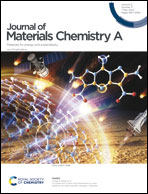Dopant clustering and vacancy ordering in neodymium doped ceria†
Abstract
Lanthanide doped cerias, show fast oxide ion conduction and have applications as electrolytes in intermediate temperature solid oxide fuel cells. Here, we examine the long- and short-range structures of Ce1−xNdxO2−x/2 (0.05 ≤ x ≤ 0.30, NDC) using reverse Monte Carlo modelling of total neutron scattering data, supported by measurements of electrical behaviour using a.c. impedance spectroscopy. Three distinct features are evident in the local structure of NDC, viz.: clustering of Nd3+ cations, preferred Nd3+-oxide ion vacancy association and oxide ion vacancy clustering with preferential alignment in the 〈100〉 direction. Interestingly, the presence of preferential dopant cation–oxide ion vacancy association is also observed at 600 °C, although diminished compared to the level at room temperature. This suggests a continued contribution of defect association enthalpy to activation energy at elevated temperatures and is reflected in similar compositional variation of high- and low-temperature activation energies.

- This article is part of the themed collection: Celebrating International Women’s day 2025: Women in Materials Science


 Please wait while we load your content...
Please wait while we load your content...